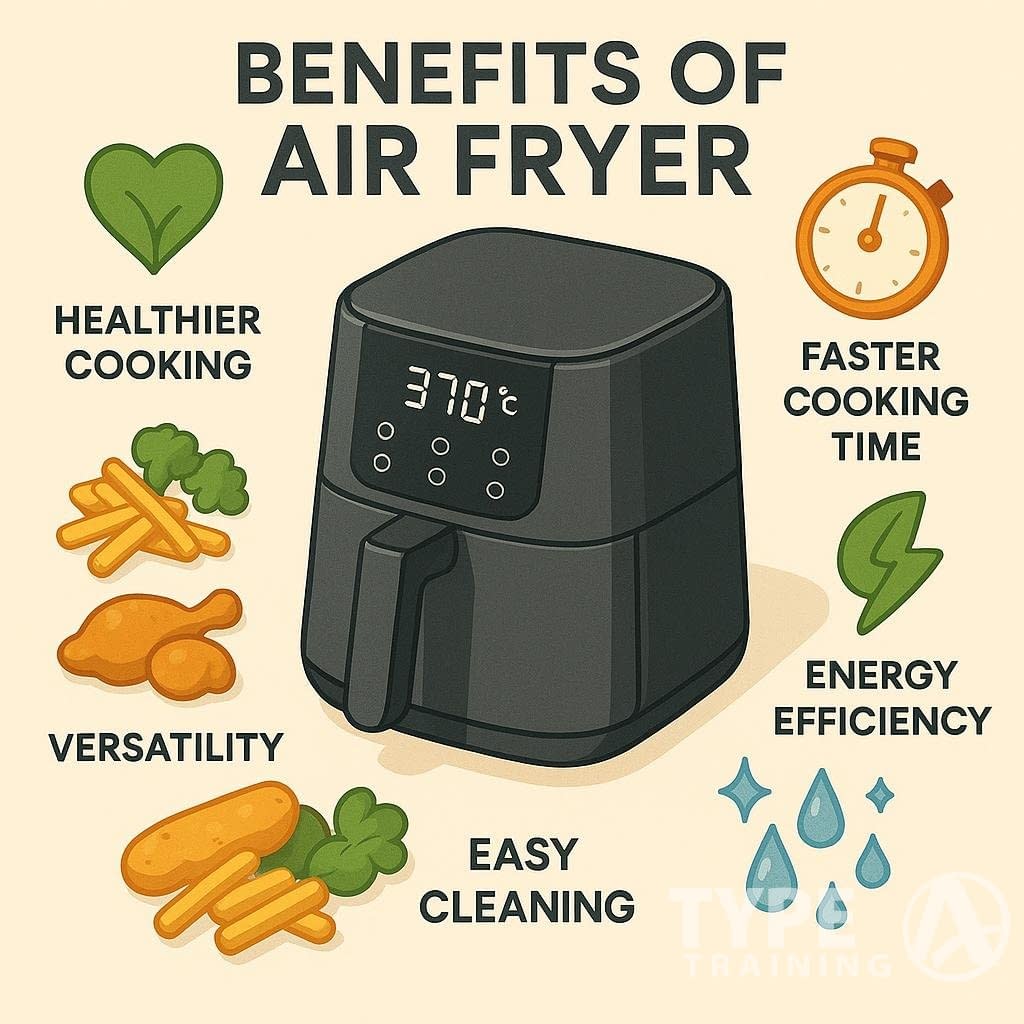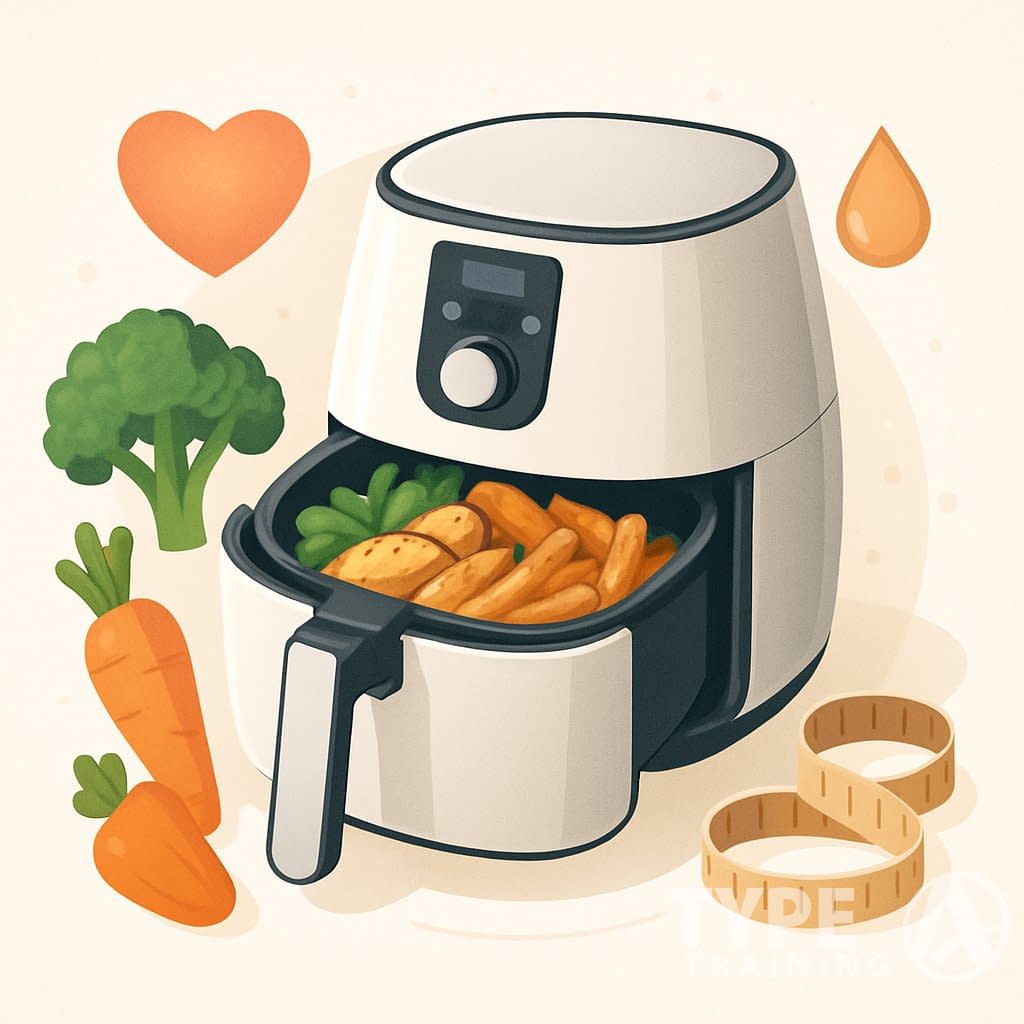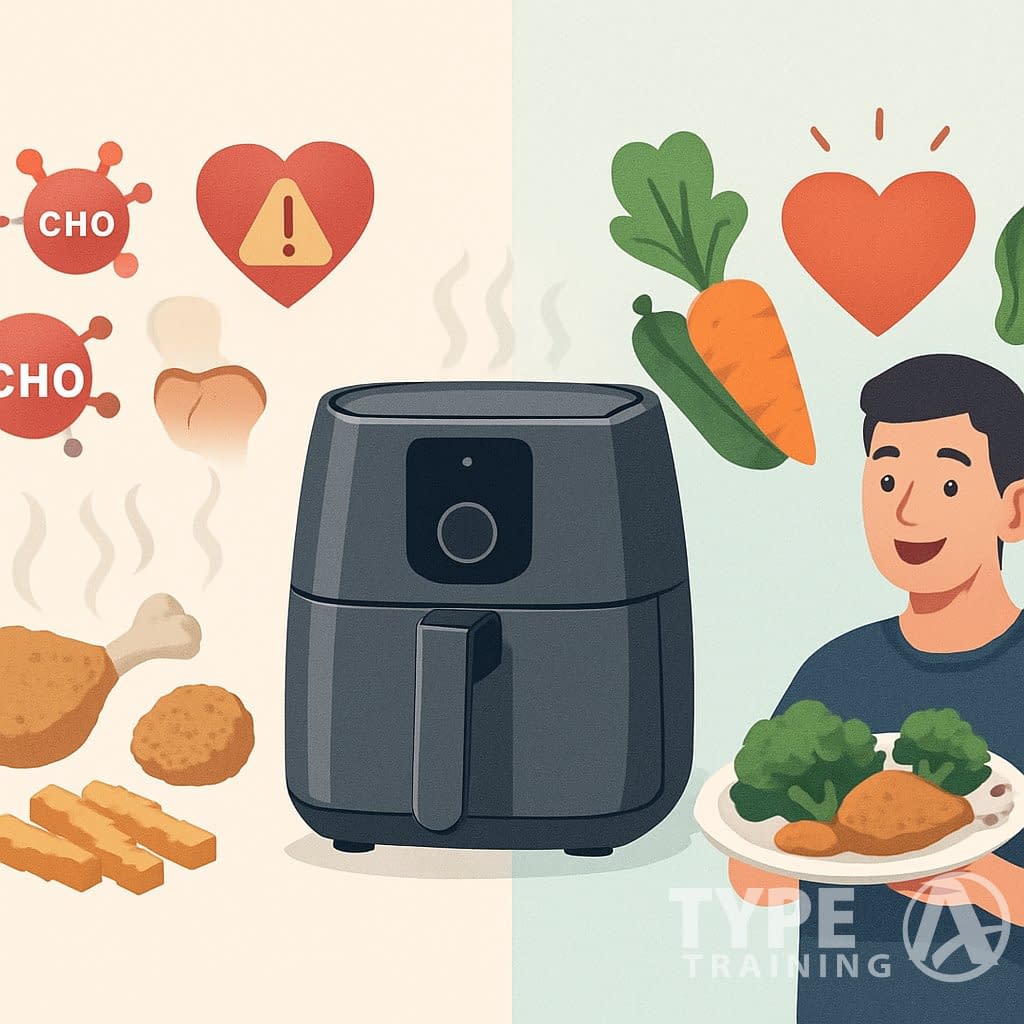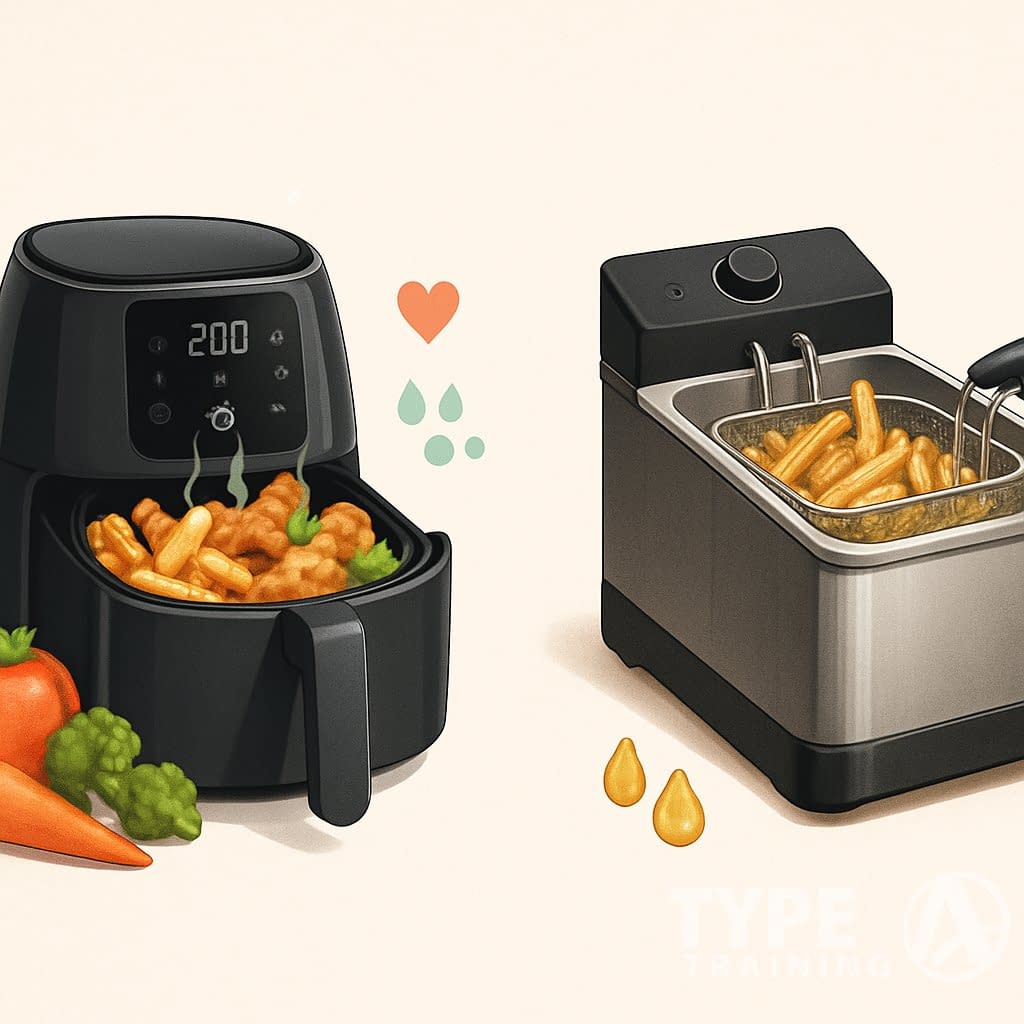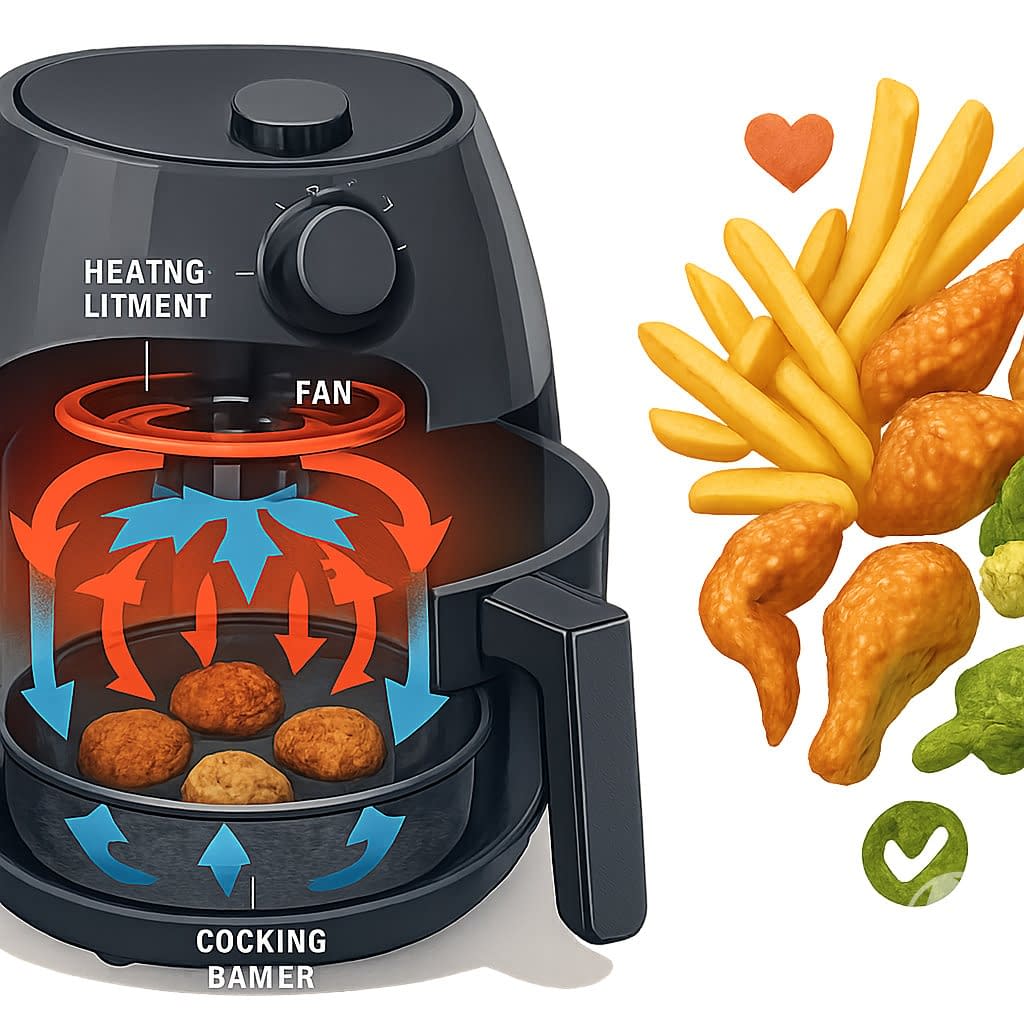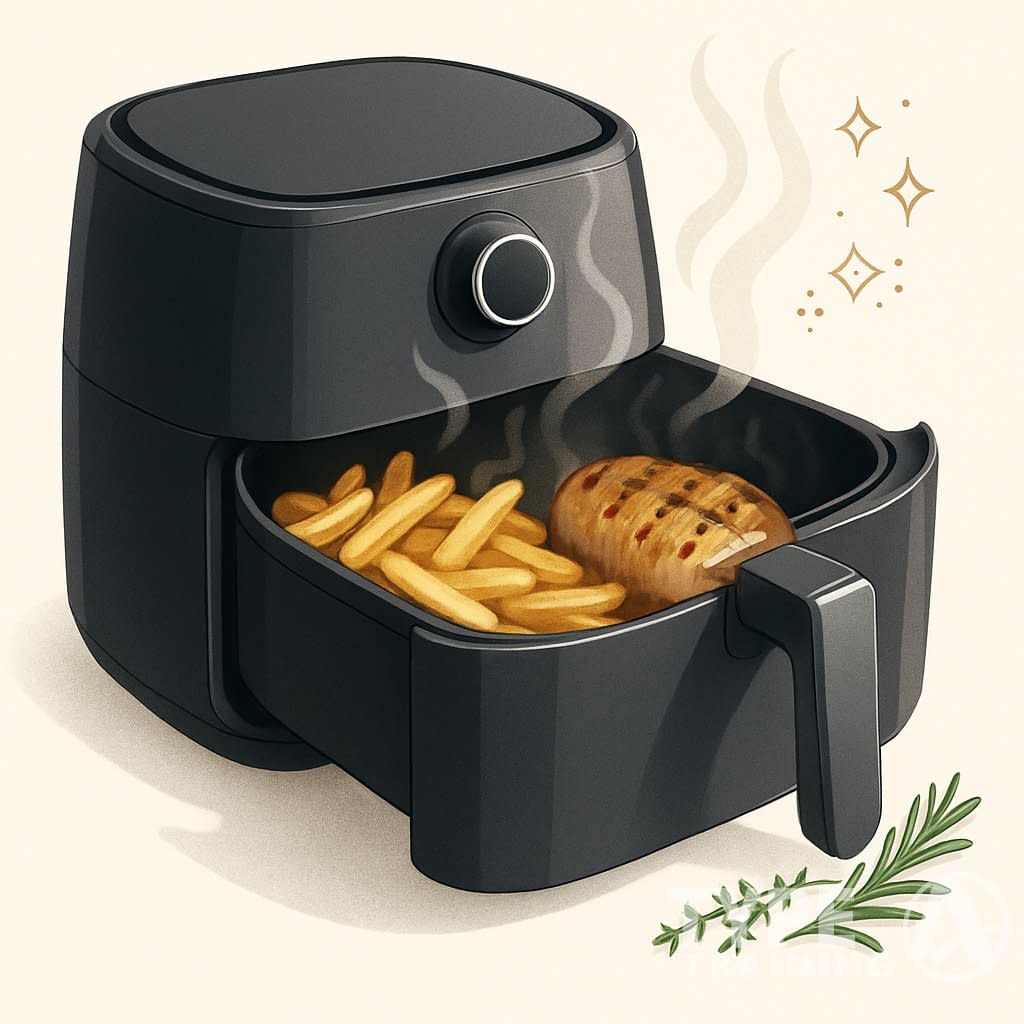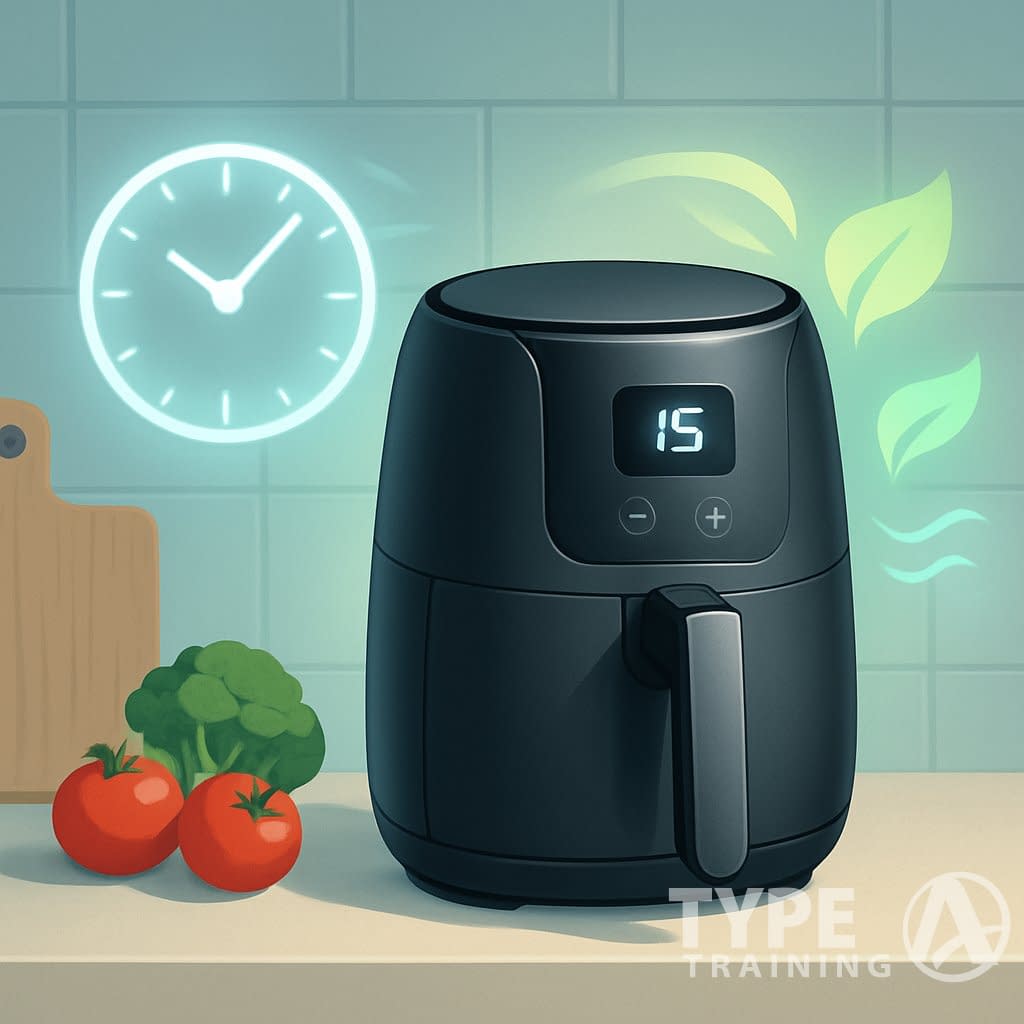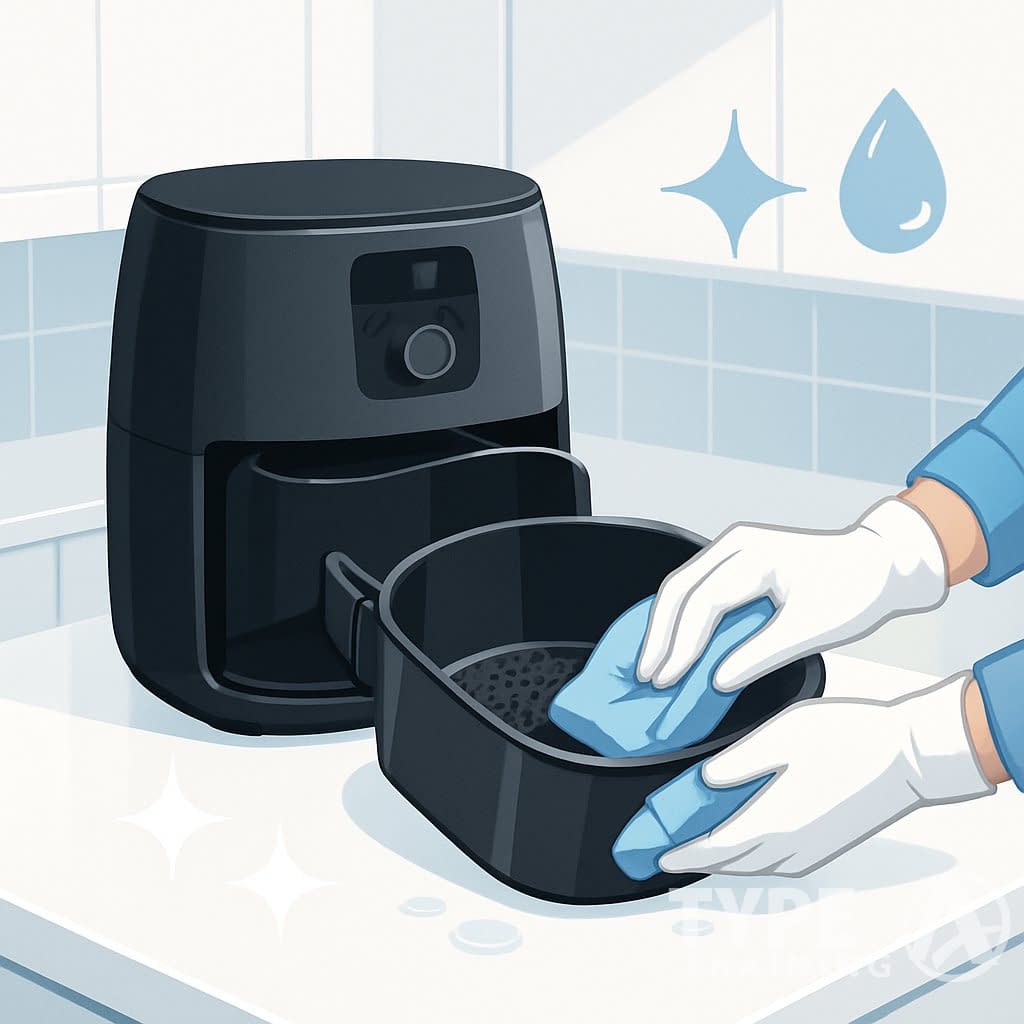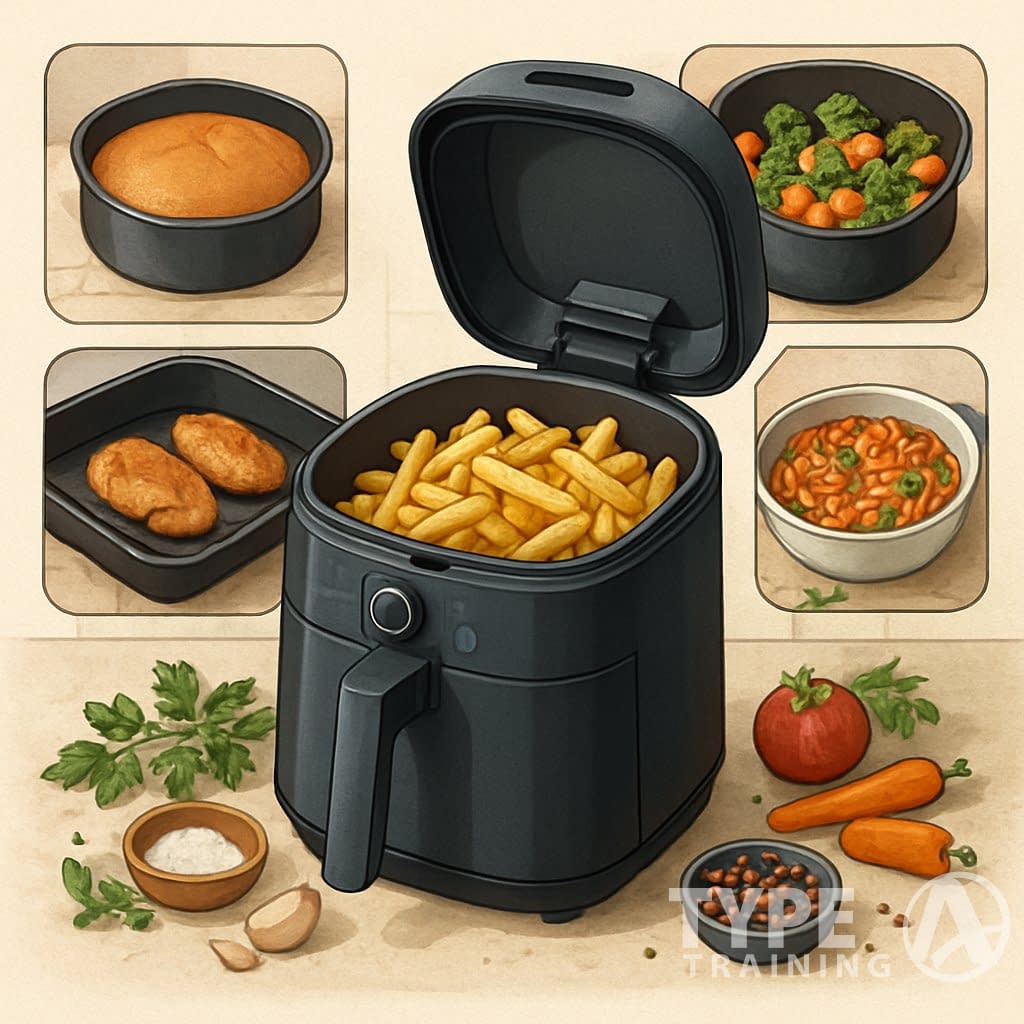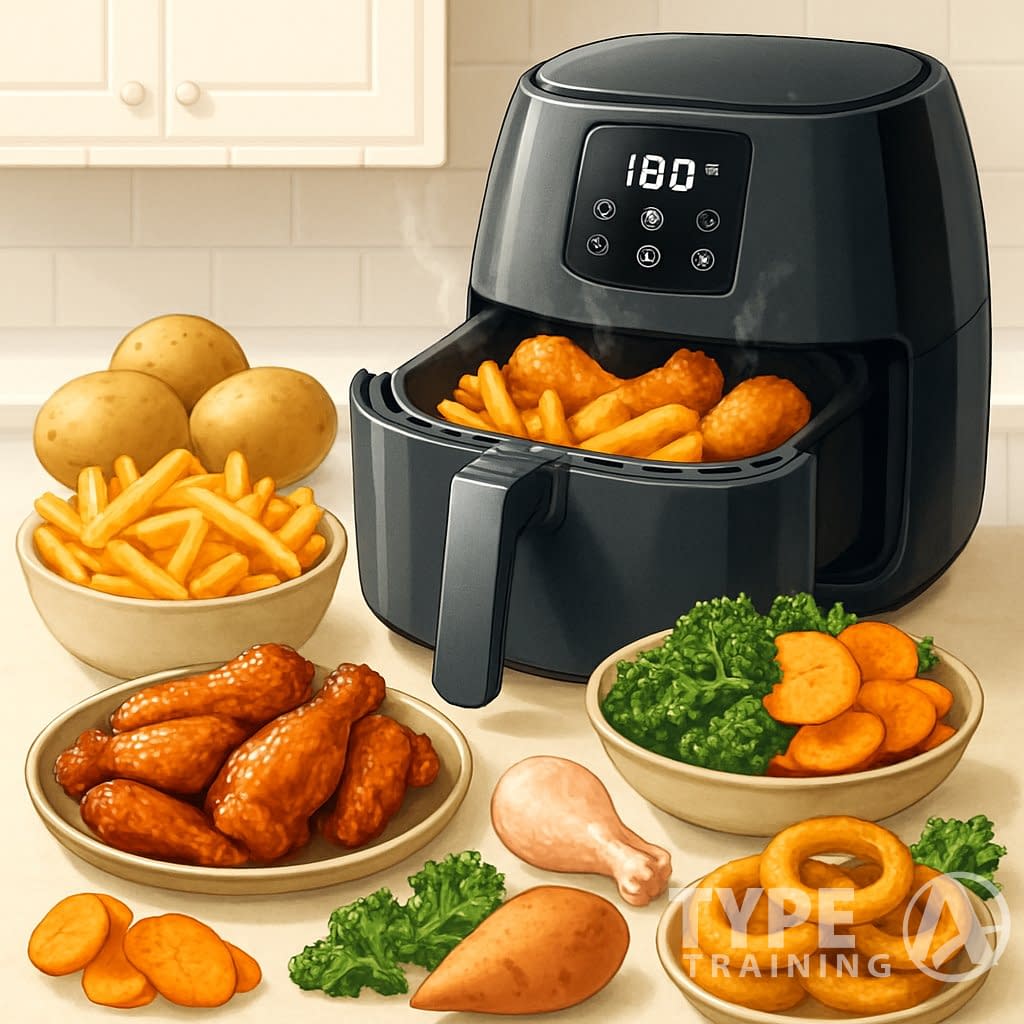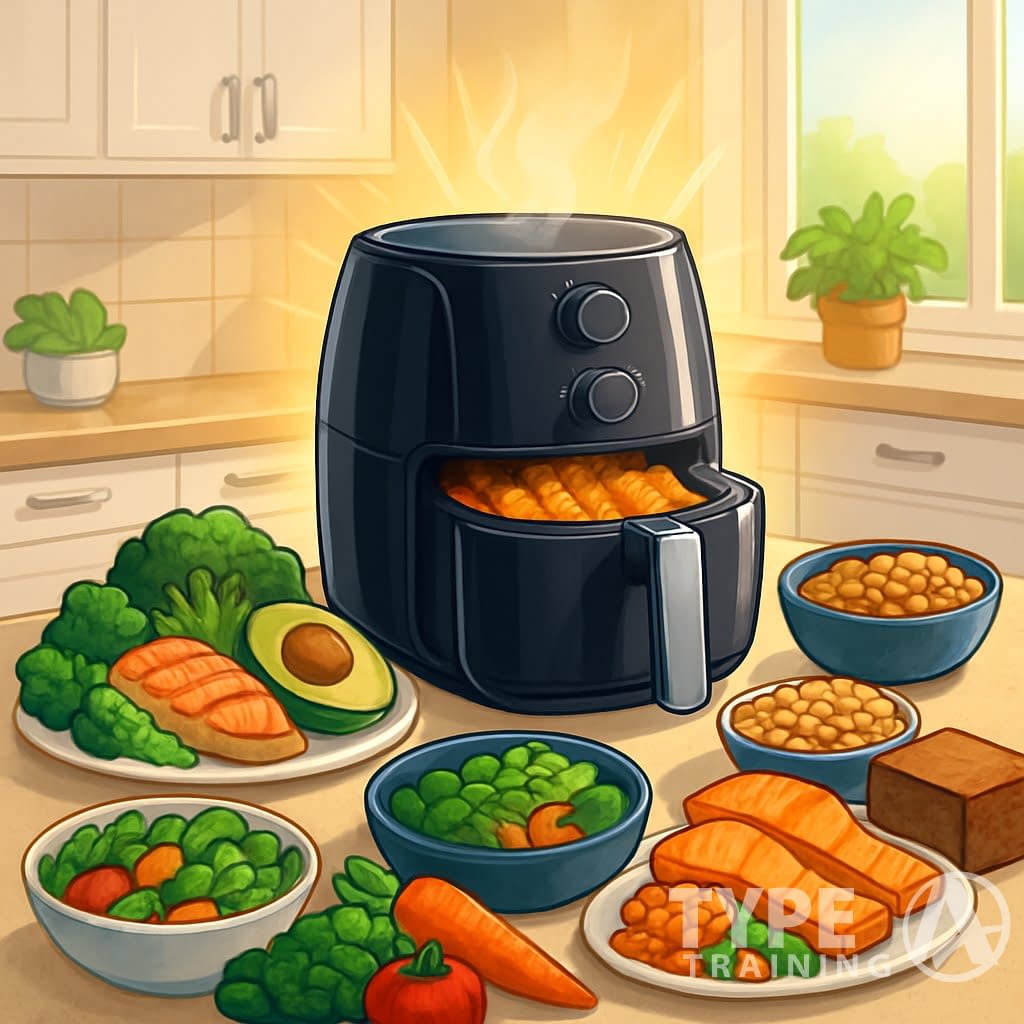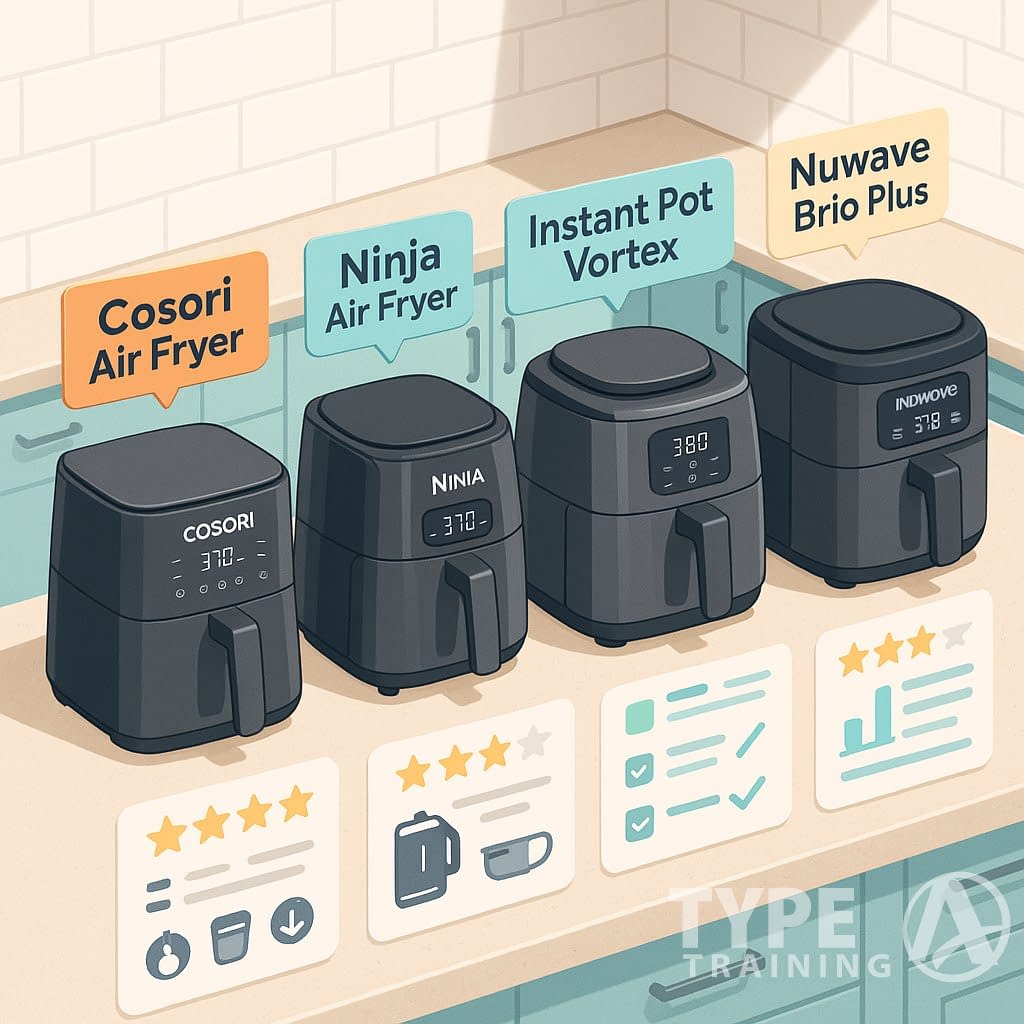Air fryers have really changed the way people cook at home. You can get that crispy, delicious texture you love from fried foods with way less oil.
These little countertop gadgets use hot air to create that satisfying crunch, skipping all the extra grease and calories. Air fryers can slash the fat in your meals by up to 80% versus traditional deep frying, but the taste and texture? Still pretty darn close.
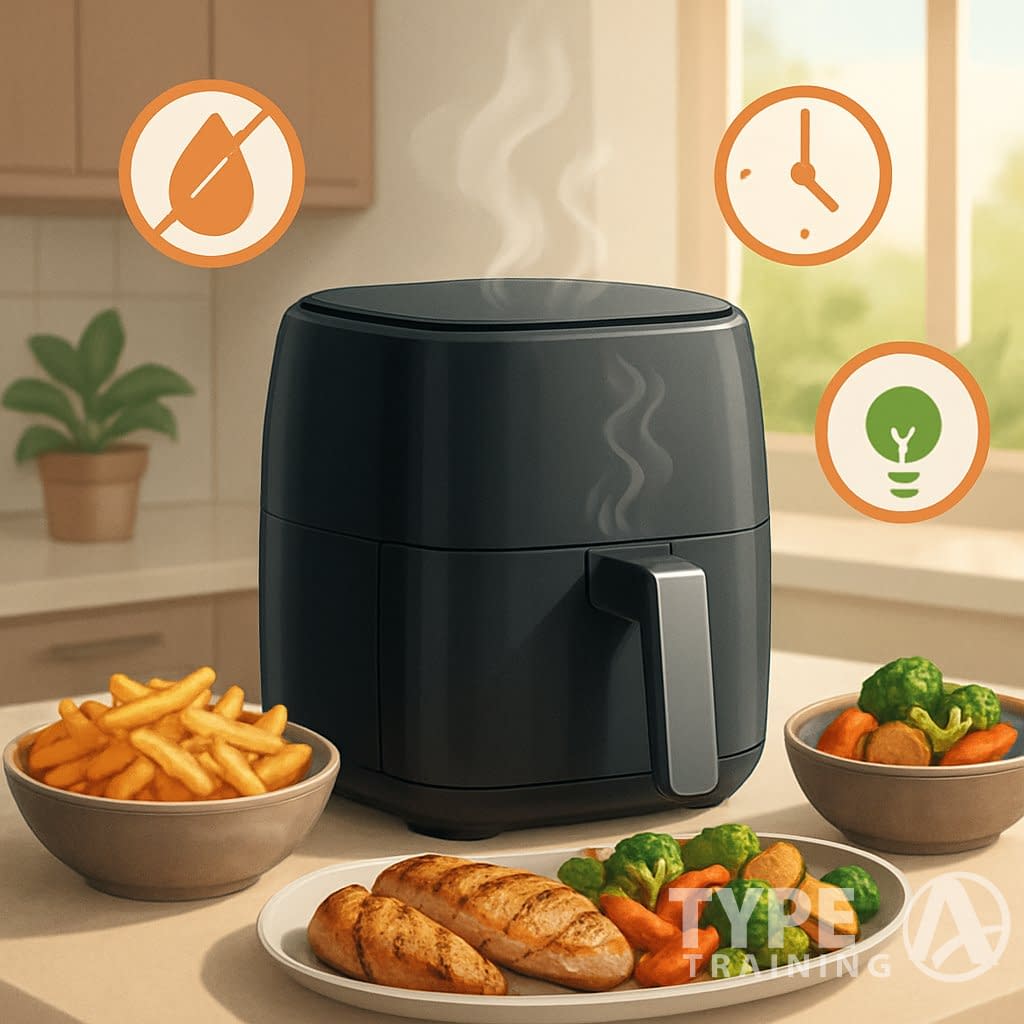
When you use an air fryer, you’re not just making healthier choices—you’re saving time and energy. Most air fryers heat up fast and cook food quicker than your average oven.
Popular posts:
They’re super versatile, too. You can fry, bake, roast, and even reheat with barely any hassle or cleanup.
Honestly, they’re a lifesaver for busy weeknights when you want something tasty but don’t want to juggle a bunch of pans or appliances.
Key Takeaways
- Air fryers make crispy, tasty food with up to 80% less oil than classic frying—so you keep the flavor, lose the fat.
- You’ll save time and energy since they cook faster and need less preheating.
- They’re versatile: fry, bake, roast, and reheat, all with easy cleanup.
Why Air Fryers Are a Healthier Cooking Method
Air fryers offer some legit health perks over old-school frying. Instead of dunking food in oil, they blast it with hot air, which means way less fat in your dinner.
You still get that crispy, flavorful result—just without all the extra grease.
Reduced Oil and Fat Consumption
Air fryers seriously cut down on oil. Deep fryers need you to dunk your food in a ton of oil, but air fryers can get similar results with just a tablespoon or even less.
This can mean 70-80% less fat in your favorite dishes. Take french fries, for example—a deep fryer might use three cups of oil, while an air fryer just needs a spritz.
Your food ends up crispy on the outside, but not soaked in oil. So if you’re trying to eat less fat but don’t want to give up fries or chicken wings, this is a pretty sweet solution.
Fewer Harmful Compounds
Deep frying oil at high temps can make some nasty stuff, like acrylamide. Air fryers produce way less acrylamide than deep fryers.
Since air fryers cook faster and at lower temps, you dodge a lot of those harmful compounds. Research even says air frying can cut acrylamide by up to 90% compared to deep frying.
They also make fewer aldehydes, which show up when oil gets overheated over and over. If you eat fried foods regularly, air frying might just be the safer bet.
Lower Calorie Meals
Using less oil means fewer calories, plain and simple. Air-fried chicken wings can have about 100 fewer calories per serving than deep-fried ones.
If you’re a fried food fan, switching to air frying could save you hundreds of calories each week without feeling like you’re missing out.
And honestly, veggies and lean proteins get surprisingly tasty in the air fryer. A little oil, a quick blast of heat, and suddenly it’s way easier to eat more of those nutrient-dense foods.
Possible Health Risks of Air Fryers
Air fryers have lots of upsides, but there are a few health risks worth mentioning.
Cooking fatty fish in air fryers can form Cholesterol Oxidation Products (COPs). Some studies say these might not be great for your cholesterol levels.
Fresh herbs like parsley might help, but the science isn’t totally settled. Also, air fryers can still make small amounts of harmful compounds at high temps.
They use less oil than deep fryers, but they can still create PAHs, which are linked to cancer risk.
Another thing—most air fryers have non-stick coatings that can release toxic gases if you scratch them or crank the heat too high (over 260°C).
- Stick to silicone utensils (not metal ones)
- Keep temps within the recommended range
- Hand wash to avoid damaging the coating
It’s easy to go overboard. Just because you can make fries with less oil doesn’t mean eating them every day is a good idea.
Air fryers can also lower the nutrient content in some foods. One study found that air frying reduced healthy fats in some fish.
And yeah, you still need a bit of oil for that crispy vibe, so it’s not totally oil-free cooking.
Comparing Air Frying to Deep Frying
Air fryers and deep fryers both make crispy food, but they do it in totally different ways. The differences really matter for your health, your food, and honestly, your sanity in the kitchen.
Oil Usage Differences
Air fryers barely need any oil—maybe a tablespoon or just a quick spray. Deep fryers? You’re pouring in cups and cups of oil.
This huge reduction in oil means you’ll save money and have less of a mess to deal with after.
Air fryers use hot air to crisp up your food, while deep fryers totally submerge it in hot oil. That’s why deep fryers use 30-50 times more oil—wild, right?
Cleanup is way easier with air fryers, too. No giant tub of used oil to toss or filter.
Calorie Comparison
The calorie cut is no joke. Air-fried foods usually have 70-80% fewer fat calories than their deep-fried cousins.
For example:
| Food Item | Deep-Fried Calories | Air-Fried Calories | Calorie Reduction |
|---|---|---|---|
| French Fries (100g) | ~320 calories | ~160 calories | ~50% |
| Chicken Wings (4 pieces) | ~430 calories | ~260 calories | ~40% |
| Breaded Fish Fillet | ~350 calories | ~220 calories | ~37% |
This calorie drop is mostly because air fryers use hot air, not oil baths, to cook your food.
If you love fried food but don’t want the extra calories, your body will probably thank you for making the switch.
Impact on Food Texture
The texture is a bit different. Deep-fried stuff is usually super crispy all over, thanks to the oil bath.
Air-fried food gets crispy, too, but sometimes the crunch is a little lighter. Some folks can’t tell the difference, but others notice air-fried food isn’t as greasy.
You can make all kinds of things in an air fryer—chicken, veggies, even desserts. The results are pretty close to deep frying, just a bit less heavy.
Want even more crunch? Try these tips:
- Give your food a light oil spray before cooking
- Don’t crowd the basket—let the air do its thing
- Shake or flip halfway through
- Pat food dry before air frying
How Air Fryers Work
Air fryers get food crispy with barely any oil, thanks to a clever heating system. They use strong heating elements and a fan to move hot air all around your food.
Hot Air Circulation
When you load up the basket, the heating element on top gets hot fast—usually between 350°F and 400°F. A fan pushes that hot air down and around, so it hits every side of your food.
The basket’s holes let air get underneath, so things cook evenly. You don’t have to flip stuff as much as you would with other cooking methods.
That blast of hot air pulls moisture off the surface, giving you that crispy outside while the inside stays juicy. Not bad for a gadget that fits on your counter.
Rapid Air Technology
Rapid Air Technology is what sets air fryers apart. It blasts superheated air around your food, swirling like a mini tornado.
This rapid motion “fries” food without dunking it in oil. Just a tablespoon of oil (or sometimes none), and the machine spreads those oil molecules evenly.
The hot air hits those tiny oil droplets, creating a reaction a lot like frying, but with way less oil—up to 80% less. Foods with natural fats, like chicken wings or salmon, really shine here.
As the air whips around, it pulls out and redistributes those fats, basting the food as it cooks.
Convection Oven Similarities
Air fryers are basically small, turbocharged convection ovens. Both use fans to push hot air around, but air fryers do it harder and faster in a much smaller space.
The main differences?
- Speed: Air fryers usually cook 20-30% faster than convection ovens.
- Size: Their small chamber focuses heat right where you want it.
- Air velocity: Air fryers use beefier fans that really get things moving.
This constant air movement is why food gets so crispy. The hot air zaps away moisture and speeds up the Maillard reaction—that’s the magic that browns food and makes it taste awesome.
Most air fryers preheat in just 2-3 minutes, while ovens can take forever—10-15 minutes feels like an eternity when you’re hungry.
Enhanced Flavor and Texture
Air fryers have a knack for turning basic ingredients into something way more exciting. The hot air circulation gives you that craveable crunch outside, but keeps everything juicy inside.
Achieving Crispy Food
Thanks to rapid air technology, you get a crispy exterior a lot like deep frying—just with a fraction of the oil. The air races around your food, triggering the Maillard reaction and building up flavor.
Cooking things like fries or wings? The crunch is legit. Breaded foods especially come out with a perfectly even golden crust.
Don’t cram too much into the basket, though. Give each piece some space so the air can do its thing. A quick spray of oil can help boost that crunch, too.
Juicy and Tender Results
Even while making crispy exteriors, air fryers lock in moisture inside. Their sealed design keeps juices from escaping like they do in a regular oven.
Proteins especially benefit. Chicken wings get crackly skin but stay juicy, and fish keeps its delicate texture without drying out.
The short cooking time helps, too—less time in the heat means less moisture loss. Marinate your meats or toss on a little oil before cooking to amp up juiciness.
Some folks let their food rest for a minute or two after cooking, which helps redistribute the juices. It’s a small step, but it makes a difference.
Time and Energy Efficiency
Air fryers really shine when it comes to speed and saving energy. They whip up meals faster and use less power than most other kitchen gadgets.
Faster Cooking Times
Meals fly through the air fryer 25-50% faster than in a regular oven. The small chamber and powerful fan are a killer combo.
For example:
- Chicken wings: 12 minutes (oven: 30 minutes)
- French fries: 15 minutes (oven: 25 minutes)
- Frozen pizza: 6 minutes (oven: 15 minutes)
On busy nights, that speed is a lifesaver. Most air fryers preheat in just 2-3 minutes—no more staring at the oven, waiting for it to beep.
Honestly, who has time to wait for a slow oven these days?
Energy Efficient Operation
Air fryers are energy sippers compared to big ovens. A typical 4-quart model pulls about 1,500 watts, almost half what a standard oven uses.
Why so efficient?
- Smaller chamber—less air to heat up.
- Shorter cook times—less time running.
- No preheating—you get right to the good part.
Depending on the brand and size, air fryers use 800-1500 watts. If you’re making smaller meals, you’ll notice a drop in your electric bill.
Switching to an air fryer for everyday meals can cut cooking energy use by about 50%. Not bad for such a little machine.
Easy Cleanup and Maintenance
One of the biggest perks of air fryers? Cleanup is a breeze. The design makes it super simple to tidy up after cooking.
Minimal Grease and Residue
You won’t deal with the greasy mess that comes with deep frying. Since food never sits in oil, there’s way less splatter and sticky residue on your counters.
Most air fryer baskets have a non-stick coating, so food slides right out. Wipe it down with a soft cloth or sponge—easy.
If something really sticks, just soak the basket in warm, soapy water for a few minutes. No need to scrub like crazy and risk scratching the non-stick surface.
A quick wipe after each use keeps your air fryer running smoothly. It takes almost no time, and your appliance will last longer.
Dishwasher-Safe Components
Most newer air fryers have removable parts that can go straight into the dishwasher. Usually, that means:
- The cooking basket
- Removable drawer or tray
- Racks or dividers
- Drip tray
Just let them cool, pop them out, and toss them in the dishwasher. This hands-off cleaning is a huge time-saver.
When shopping, check if the model says its parts are dishwasher-safe. Some pricier models have non-stick coatings that hold up through lots of cycles.
Between deep cleans, a quick wipe inside with a damp cloth does the trick. The outside just needs a microfiber cloth to keep it looking sharp.
Versatility and Cooking Functions
Air fryers are surprisingly versatile. They’re not just for fries and wings—you can use them for all sorts of cooking jobs, and they often outshine bigger appliances.
Multi-Functional Appliance
Today’s air fryers are like kitchen Swiss Army knives. Most come with preset functions for different foods, so meal prep gets way easier.
You can dehydrate fruits and veggies for healthy snacks, or use special settings to proof dough or keep food warm. Some models even connect to your phone, so you can check on dinner from the couch or scroll through recipes designed just for air fryers.
The touchscreen controls on newer models are pretty intuitive, too. No need to dig through a manual every time you want to try something new.
Baking, Roasting, and Grilling
Your air fryer acts like a mini convection oven, circulating hot air for even cooking. It’s awesome for baking cookies or cakes with crispy outsides and soft centers.
Roast veggies or meats and you’ll get lovely caramelization and browning, without drying things out. It’s like oven-roasting, but faster and (honestly) sometimes tastier.
The grill function is a fun bonus. You can get those grill marks and a hint of smokiness—no outdoor grill required. Burgers, chicken, even steak turn out great, especially if you use the grill pan accessory.
Reheating Food
Reheating leftovers in the air fryer is a total game-changer. Pizza comes out crispy, and fried foods get their crunch back instead of going limp like they do in the microwave.
The air fryer heats evenly, so you avoid those weird cold spots. No more soggy fries—they taste almost fresh.
Usually, 3-5 minutes at 350-375°F does the trick. No need for paper towels or extra fuss—the contained basket keeps things neat while bringing your leftovers back to life.
Popular Foods Cooked in Air Fryers
Air fryers really shine when it comes to making crispy, delicious foods with way less oil than you’d use for deep frying. Tons of everyday favorites come out great in these handy appliances, so you get both convenience and healthier meals without much fuss.
Crispy Vegetables
Vegetables get a major upgrade in an air fryer. Brussels sprouts turn golden and caramelized on the outside, but stay tender inside—just toss them in a bit of olive oil and your go-to seasoning.
Cauliflower florets? They become irresistible, crispy snacks in about 12-15 minutes at 380°F. If you want a little extra, try sprinkling parmesan cheese over them for the last couple minutes.
Asparagus spears also come out perfect, usually needing just 7-9 minutes at 400°F. The high heat gives them a roasted edge but keeps the color and nutrients intact.
Zucchini coins are another fun one. Slice them about a quarter-inch thick, toss them in, and air fry at 375°F for 8-10 minutes. It’s a healthy swap for potato chips, honestly.
Chicken Wings and Proteins
Chicken wings in the air fryer? Game changer. Pat them dry, hit them with your favorite spices, and cook at 380°F for 25-30 minutes, flipping halfway for even crispiness.
Salmon fillets cook up fast—just 7-9 minutes at 400°F. The hot air does a great job sealing in moisture, so you get tender, flaky fish every time.
Pork chops come out with a gorgeous golden crust. Just season, cook at 375°F for about 12-15 minutes, and you’ve got juicy, crispy chops ready to go.
Tofu cubes get surprisingly crispy too. Press out the moisture, cut into cubes, toss them with cornstarch and your favorite seasonings, then air fry at 375°F for 15 minutes. Give the basket a shake halfway through for good measure.
Homemade Snacks
French fries might be the most popular thing people make in air fryers. Soak cut potatoes in cold water for half an hour, dry them off, toss with a little oil, and air fry at 380°F for 15-20 minutes. You end up with crispy fries and way less fat.
Mozzarella sticks are a breeze. Freeze your breaded cheese sticks for about 30 minutes, then cook at 390°F for 6-8 minutes. That helps keep the cheese inside and gets you that perfect crunch.
Homemade churros are easier than you’d think. Pipe choux pastry into the basket, give them a quick spray of oil, and air fry at 375°F for 8-10 minutes. Once they’re golden, roll them in cinnamon sugar while they’re still warm—so good.
Vegetable chips like kale, beet, or sweet potato turn out super crispy at 350°F for 8-12 minutes. Use just a little oil, and season after cooking for a snack that’s actually pretty healthy.
Air Fryers and Dietary Lifestyles
Air fryers can fit right into all sorts of dietary lifestyles. They help you cut down on calories but keep the flavor, and they’re a solid option for anyone with specific nutrition needs.
Supporting Weight Management
Because air fryers use a lot less oil than deep frying, they’re a smart choice for weight management. By cooking with hot air instead of oil, you get that satisfying crispy texture—sometimes with up to 80% less fat.
A typical batch of air fryer fries has about 4-6 grams of fat, compared to 15-20 grams when deep-fried. That difference adds up, especially if you’re keeping an eye on your daily calories.
Shorter cooking times and lower temps help air fryers preserve more vitamins and minerals in your food. That’s a nice bonus, right?
Plus, since air fryers have smaller baskets, you naturally end up making more reasonable portions. That alone can help keep your servings in check.
Fit for Special Diets
Air fryers are surprisingly versatile for folks with special dietary needs. If you’re low-carb or keto, you’ll love how easy it is to make crispy veggie chips and juicy proteins—no breadcrumbs needed.
Plant-based eaters, you’re in luck too. Air fryers turn tofu, tempeh, and veggies into crave-worthy bites with awesome texture.
Ever tried cauliflower “wings” or crispy chickpeas? With an air fryer, they’re basically foolproof and super satisfying.
If you manage diabetes, air frying cuts back on added fats but doesn’t skimp on flavor. That can make blood sugar management a little less of a headache.
Gluten-free? No problem. You can still get that crunch by swapping in almond flour or cornstarch instead of regular batter.
And if you’re aiming for a heart-healthy plate, air frying’s low-oil style helps you keep fat intake down while still enjoying meals that taste great. Handy, right?
Air Fryer Review: Top 3 Models Compared for Home Cooks
Looking for the perfect air fryer to elevate your kitchen game? We’ve rigorously tested the market’s leading contenders to help you make an informed decision. From compact basket-style options to innovative oven designs, our comprehensive review examines performance, features, and value across three standout models. Whether you’re cooking for one or feeding a family, these top performers deliver crispy, delicious results with minimal oil and maximum convenience.
|
Primary Rating:
3.5
|
Primary Rating:
3.5
|
Primary Rating:
3.5
|
Primary Rating:
3.5
|
|
|
|
|
|
Cosori 5-Quart Air Fryer: Affordable Performance in a Compact Package
The 5-quart Cosori air fryer delivers impressive results without breaking the bank. Its user-friendly interface features intuitive controls and a cool-touch handle for safe operation. Even air frying novices found it straightforward to produce crispy Brussels sprouts, perfectly cooked fries, and delicious wings. A thoughtful shake/turn reminder ensures even cooking, while the sleek, compact design complements most kitchen aesthetics.
Despite marketing claims of being a “9-in-1” appliance, this is fundamentally a dedicated air fryer—and an excellent one at that. It offers seven food-specific presets plus preheat and keep-warm functions. While not explicitly designed for dehydrating, toasting, or baking, it excels at its primary purpose. The spacious basket accommodates complete recipes, and cleanup is a breeze with both the basket and crisper plate being dishwasher-safe.
Type: Basket-style | Capacity: 5 quarts | Dimensions: 10.7 x 10.8 x 11.9 inches | Maximum Temperature: 450 degrees
Ninja 4-Quart Air Fryer: Exceptional Performance with Versatile Functions
Ninja continues to impress with their innovative kitchen solutions, and their air fryer stands as a testament to their quality. During our testing, we found it remarkably intuitive, requiring no manual consultation to operate effectively. It delivered outstanding results across all tests, from crispy French fries to perfectly cooked shrimp and wings. Notably, the wings prepared in the Ninja were the standout of our entire testing process, achieving that ideal balance of crispy exterior and juicy interior that wing enthusiasts crave. Post-cooking cleanup is effortless, with both the basket and crisper plate being dishwasher-safe.
Beyond standard air frying, the Ninja offers additional versatility through its reheat, roast, and dehydrate presets. While the dehydrate function provides creative options for garnishes, the 4-quart capacity does present some limitations for larger quantities. The basket’s configuration necessitates cooking in smaller batches for optimal results—we needed to divide our coconut shrimp into three separate batches to ensure even cooking.
In our final analysis, both the Cosori and Ninja impressed considerably, making the top selection challenging. The Cosori ultimately prevailed due to its superior price-to-capacity value. However, the Ninja’s additional functionality makes it an equally compelling choice for many kitchens.
Type: Basket-style | Capacity: 4 quarts | Dimensions: 8.5 x 12.1 x 11 inches | Maximum Temperature: 400 degrees
Instant Pot Vortex: A Revolutionary Air Fryer Oven with Rotisserie Function
The Instant Pot Vortex transcends typical air fryer design, functioning more as a versatile countertop oven with air frying capabilities. This innovative approach from the brand known for its pressure cookers delivers exceptional results across all air frying applications, with remarkably even cooking throughout its generous 10-quart capacity.
What truly distinguishes the Vortex are its included rotisserie basket and spit—rare features in the air fryer market. A whole chicken emerges perfectly cooked in just 45 minutes, rivaling traditional oven-roasted results. Beyond poultry, the rotisserie function proves ideal for items like french fries, eliminating the need for manual flipping during cooking. However, delicate or breaded foods may not fare as well with the rotation and movement.
For standard cooking, the Vortex utilizes a tray system rather than a conventional basket. This design requires tongs or a spatula for mid-cook adjustments, and oven mitts are necessary for handling the heated tray—similar to traditional oven cooking.
Post-cooking cleanup couldn’t be simpler, with all removable components—including the drip pan—being dishwasher-safe. While the manual suggests lining the drip pan with foil, we found this unnecessary given how effortlessly it cleans.
Type: Air fryer oven | Capacity: 10 quarts | Dimensions: 13.2 x 13.2 x 14.4 inches | Maximum Temperature: 400 degrees
Nuwave Brio Plus 8 Qt: Precision Cooking with Modern Digital Controls
The Nuwave Brio Plus 8 Qt Air Fryer represents a significant redesign based directly on customer feedback. This new and improved model features a complete overhaul in design, functionality, and even color options, creating a stylish approach to healthy cooking that addresses previous customer concerns.
At the heart of the Brio Plus is its full digital touch screen control system, eliminating traditional analog buttons and faded silk-screened lettering. The interface provides a seamless, futuristic cooking experience with easy-to-read cool white digits that remain clearly visible in any lighting condition, ensuring user-friendly operation regardless of kitchen environment.
Temperature precision distinguishes this model, with settings adjustable from 50°F to 400°F in exact 5°F increments. Unlike basic air fryers that simply toggle heating elements on and off, the Brio Plus maintains continuous operation with constant micro-adjustments throughout the cooking process, resulting in more consistent results.
Safety features include automatic cooking pause when the air fry basket is removed and automatic resumption when replaced. The redesigned air circulation riser fits securely, eliminating potential mishaps during operation. Importantly, the unit is completely PFAS-free, ensuring healthy meals without concerning chemicals.
Type: Basket-style | Capacity: 8 quarts | Temperature Range: 50-400°F | Power Options: 700W, 1500W, 1800W

